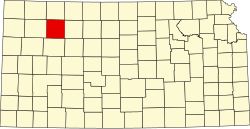Sheridan, Kansas | |
|---|---|
 | |
| Coordinates: 39°30′33″N100°29′52″W / 39.50917°N 100.49778°W | |
| Country | United States |
| State | Kansas |
| County | Sheridan |
| Elevation | 2,743 ft (836 m) |
| Population | |
• Total | 0 |
| Time zone | UTC-6 (CST) |
| • Summer (DST) | UTC-5 (CDT) |
| Area code | 785 |
| GNIS ID | 482587 [1] |
Sheridan is a ghost town in Sheridan County, Kansas, United States.



